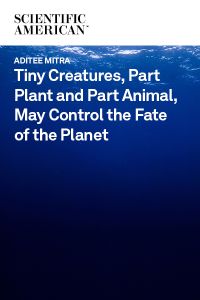
Tiny Creatures, Part Plant and Part Animal, May Control the Fate of the Planet
Mixotrophs, tiny sea creatures that hunt like animals but grow like plants can change everything from fish populations to rates of global warming.
Recommendation
Mixotrophs combine two ways of getting energy. They photosynthesize energy from sunlight like plants, but they also eat prey like animals. Mixotrophic plankton were long considered to be anomalous, but they are the most prevalent plankton in the oceans. Plankton form the base of the marine food chain, so a deeper understanding of how they work is essential to understanding the whole ecosystem, from carbon sequestration to fish populations. This article will compel people who are interested in discoveries in marine biology that might have an impact on global carbon levels.
Summary
About the Author
Aditee Mitra specializes in mixotroph and zooplankton research and is a plankton systems dynamics modeler. She is a senior lecturer in bioscience at Swansea University in Wales and a visiting professor at the Free University of Brussels.








Comment on this summary